|
|
 |
|
MOROCCO -
Atlas Mountains |
|
|
Atlas Mountains
From Marrakesh we took a side trip into the Atlas Mountains by bus,
an actual tour. The bus was practically all Germans with a few
French couples.
In the Atlas Mountains Sahara steppes and red earth valleys mark the
exact strata where tectonic plates shifted billions of years ago and
civilisation surfaced from a rugged seabed.
The bus made a few roadside stops for photos. Right a
women picks watercress from a creek running through the rocky wedge
of the canyon. |
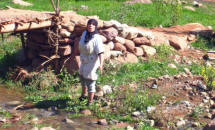
|
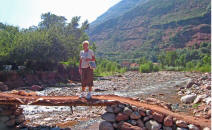
|
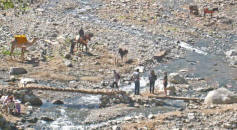 |
The rough rocky flatland
around the river was full of activity...camels, donkeys, horses,
goats and dogs.
Pears for sale along the roadside |

|
Morocco has been inhabited by Berbers for at least the last 5000
years. The Arabs conquered the territory that would become Morocco in
the 7th and 11th centuries. Berbers are 70% of the whole population and
speak a different language than Arabic state language.
The Atlas Mountains is very rural and
primitive, and Kif is grown in abundance in the area. |
|
Our destination, a little village in a green oasis valley cut deep between
the high treeless barren brown shale mountains.
Children, dressed up in costume, paraded
down the hill, singing and dancing when we arrived. |
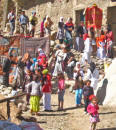 |
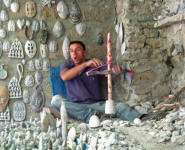
We watched a young man making decorative hangings and pots from the
clay, using only primitive hand tools.
Otherwise the town was very sleepy, not even the usual line-up of
souvenir shops! |
|
Hike to Waterfalls
We did a 3 hour trek to 5 Waterfalls. It was an arduous climb and we got some serious
exercise.
We had a guide that took us past
the first waterfall on a trail that required assistance to
climb up a steep rock face. Then it led us back into the
mountainous range, void of tourists and other hikers. |
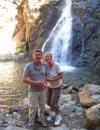
|
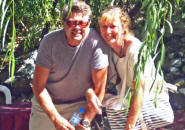
|
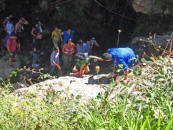
|
|
We trekked along dusty paths
amidst shale and lava rock. A distant village displayed
its stacked rectangular houses in various dull hues of
earthy tones. Suddenly the haunting call to prayer
echoed through the Valley. Our guide stopped the hike
and all conversation immediately and bowed in
prayer.
|
|
Later we were shuffled into a Moroccan (read "tourist")
restaurant where the meals were 120 dirhams ($15) each. Seeing the price we promptly left the group and headed down
the road where we ate the exact same meal for less than 1/2 the price!
The traditional meals in Morocco are
couscous and tujine, a meat and potato dish cooked in special
oven proof containers (right). We had a great lunch of chicken
tujine.
|
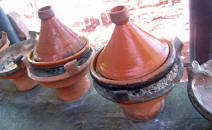 |
|
|
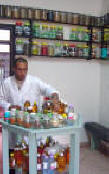 |
Argan Oil
On our way back, the bus stopped to
channel us into a Spice Centre, where a Medicine Man displayed
his potents and spices; cumin
turmeric, curries, garam marsala. He demonstrated many used for the spices and oils, many of which
were made from Argan Oil.
Organic Argan oil is the "new olive oil" used to season salads with its nutty
flavor. It comes from wrinkled Argan trees unique to Morocco, resistant
to heat surviving temps of 50 deg C. Argon Oil has become vital to the local economy - firewood, fodder for goats,
oils for cooking, and is used to make anti wrinkle creams. Berber women harvest the fruit in the spring, feed it to the goats, whose digestive juices
dissolve the tough outer shell. The seeds are recovered form
the goat's dung and the kernels are spit, toasted, pulped and pressed. To
produce 1 litre requires 30 kg of nuts and 15 hours of manual labor.
|
 |
|
return to top of page |